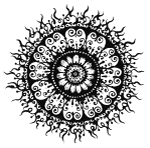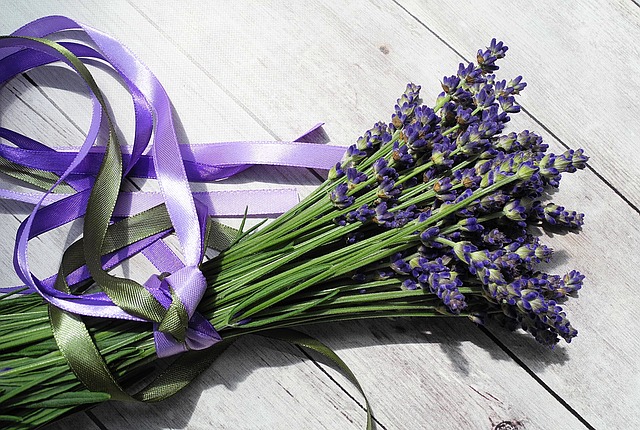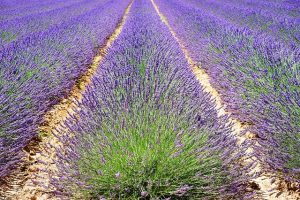
From the very first time I looked at pictures of Provence and the beautiful rows of flowering lavender fields, I wanted to grow my very own lavender plant. I was just happy with just keeping one alive, so I wasn’t thinking about rows of lavender! But one single plant can give you bunches of lavender flowers, several times a year depending on where you are living, and depending on which variety you are growing. If you want to read more about different varieties of lavender, have a look at this post.
For today’s post, I am simply looking at the ways you can use the flowers of Lavandula angustifolia, also known as English Lavender, even though plenty of it is grown in France…. and that, my friends, is why we look at the Latin name!
So let’s look at the 5 ways we can use Lavender flowers:
- The Flowers. You have picked a bunch of lavender flowers, and now is the fun of working out what to do with them! English lavender, L. angustifolia, will keep well – these are the bunches you see in any herb display, and they hold their colour beautifully. L. spica tend to lose their colour and the shape of the flowers does not really lend to making herb sachets or pouches. Hang bunches of lavender upside down to dry, so the stems stay straight. Then display them anywhere – in a vase, on a shelf, tied in a posy.
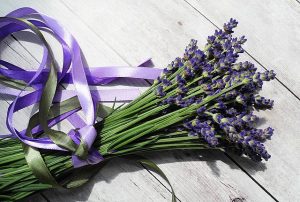
Strip the flower buds from the stem and make sleep pouches or pillows. Lavender is known for their calming and sedating properties, its gentle perfume serenades you to sleep. Add lavender buds to homemade bath salts – these look and smell beautiful as little gifts, or add sprigs of lavender when you are drawing a bath for a goddess-inspired immersion.
- Herbal teas or infusions. A small pinch of lavender buds, combine with chamomile, makes a lovely bedtime tisane to aid sleep. Add a whole lavender spear into a jug of fresh, chilled water with some slices of lemon for pretty, summer drink.
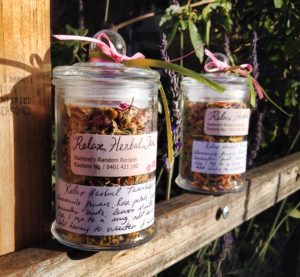
- Oil-infusions. Place some dried lavender flowers into a mason jar, and top with a light carrier oil, like sweet almond oil or light olive oil. Leave on a sunny window sill for a few weeks to infuse. It is important that the flowers are dry before infusing in oil, as water content can cause mold to grow. L. angustifolia is best for this, as they dry well. We tend not to infuse the leaves of the lavender as there is greater water content in them and not enough volatile compounds (the stuff that makes essential oils). Strain the oil when ready, squeezing out excess oil. The spent flowers can then be used in a shower as a body scrub – add sugar or salt to create a simple body scrub that still smells of lovely lavender. The infused oil can be used as a massage oil, or to make creams or lotions (I use infused lavender oil, along with lavender hydrosol and lavender essential oil to create a “whole” lavender cream or lotion, as I believe the “whole is greater than the sum of its parts”).

- Flower Essences. Flower essences are made with the energetic properties of the plant and then “preserved” with alcohol. You can make them to the rhythm of the moon, calling in the New Moon for new beginnings, or the Full Moon for fulfillment of Intentions, and the dark of the moon for reducing symptoms. Tuning in to the healing and magical properties of Lavender, and combining them with the energies of the moon can create powerful essences, which are unique to the person creating them.
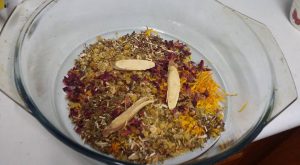

- This is where we approach the herbal medicine aspect of Plant Medicine. Tinctures are usually alcohol-based, or water-and-alcohol-based products. Lavender flowers are macerated (infused) in alcohol or a mixture of alcohol and water. Lipophilic (oil-loving) volatile organic compounds (VOC) will infuse into the alcohol, while hydrophilic (water-loving) VOCs will infuse in the water. With a water-and-alcohol tincture, we are able to capture both hydrophilic and lipophilic VOCs to create a more holistic tincture. Dosage of tinctures is dependent on the condition one wishes to treat – note my use if the words “condition” and “treat”, so you would need to obtain more knowledge in this part of herbal medicine, or consult a herbalist.
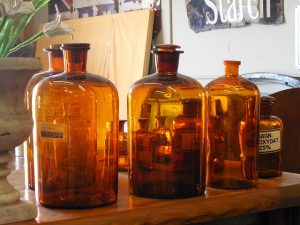
So there we have 5 different ways we can experience the healing and magic of a plant, on top of learning to care and maintain the whole plant itself, and note that I did not even cover the essential oil (I will cover Lavender essential oil therapeutic properties another day). The journey to get to know a plant, and thus its plant magic, is an experiential one, and the best advice I ever received in learning plant medicine is to create a relationship with the plant, on all levels. And then there are many, many more plants to get to know and love in the world of plant magic and medicine. Happy journey-ing! 😊
